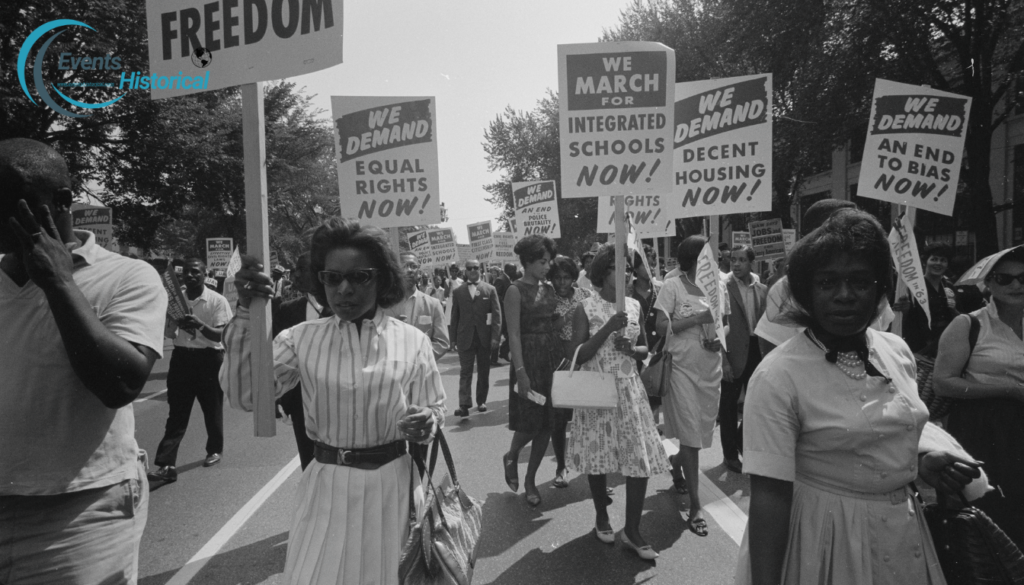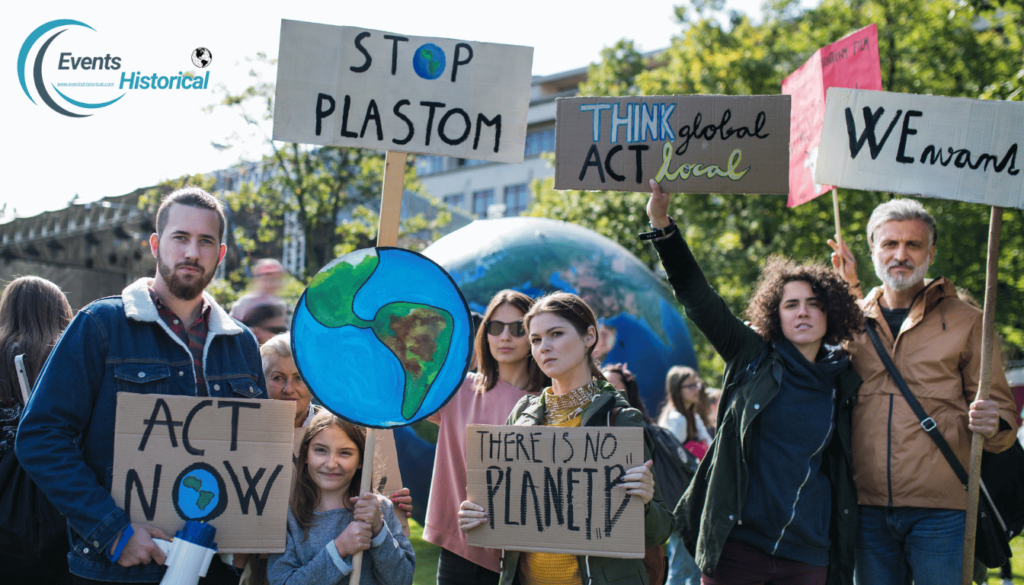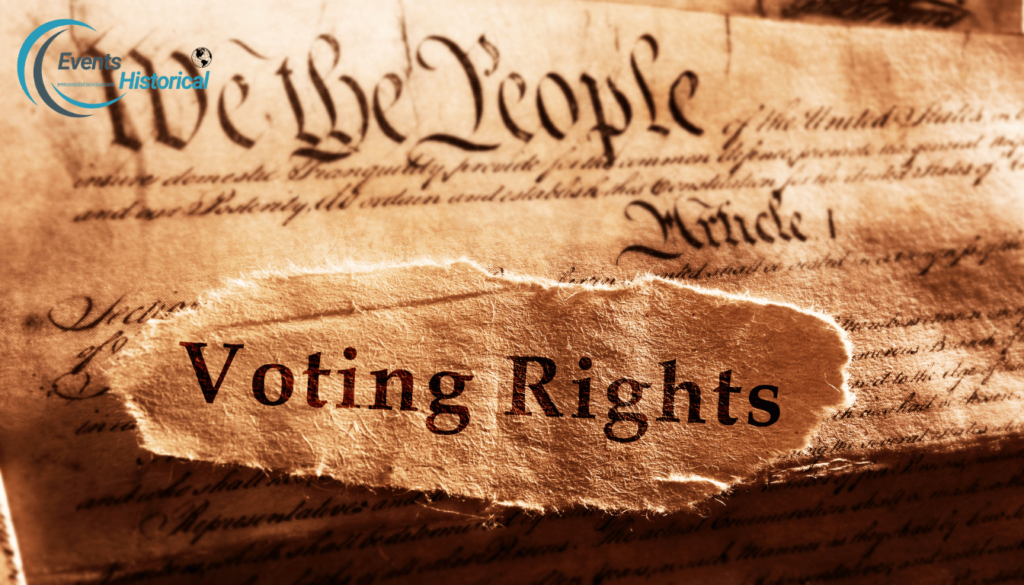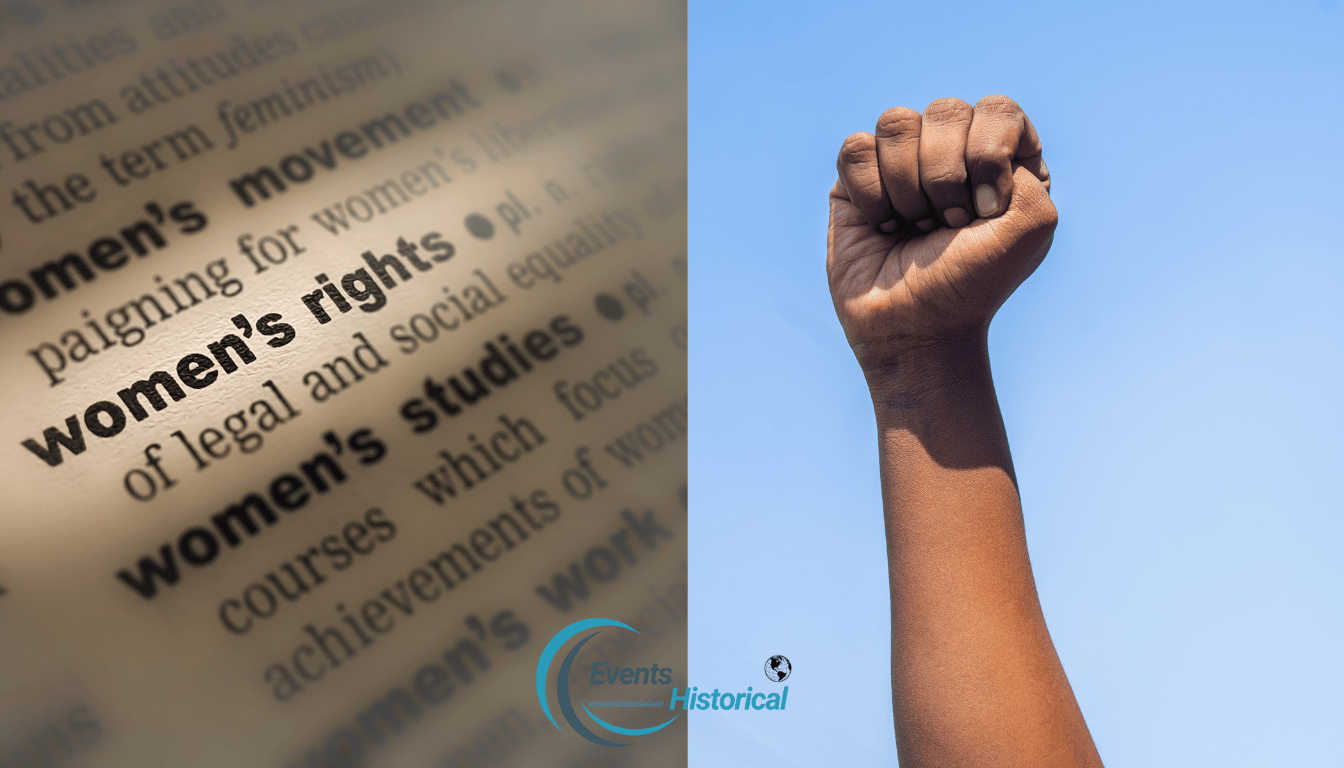Learn about Civil Rights Movement personalities and events that shaped America as well as impacted the whole world.
During the civil rights movement, America witnessed social change and social struggle over the Blacks. It is best described as the era of brave men and events which brought about a change to the societies of the nation.The period of the Montgomery Bus Boycott to the March on Washington to demanded the elimination of racial discrimination and segregation throughout the United States.
When you traverse this significant epoch, you will meet hope givers such as Martin Luther Jr., Rosa Parks, and Malcolm X. You will also get to know significant bills passed as a result of the civil right movement, such as the Civil Rights Act of 1964 and Voting Right Act of 1965 which facilitated the fight against Jim Crow law and voting rights of black people respectively. Also, you will learn about the different tactics used by activists, which range from peaceful protest, to Black Power, as the struggle for equality and justice continue into the present in America.

Segregation and Discrimination in the Jim Crow Era
The period of history concerning Jim crow system was from post Reconstruction from 1877 to the civil right movement from the 1950s. At this time African Americans suffered from lack of civil rights, and legal/ illegal Jim Crow laws were in place to oppress the blacks and keep them subordinate to the whites.
Separate But Equal Doctrine
Jim Crow laws were civil laws practiced in all the Southern states after Reconstruction that followed the Civil War. These laws required that blacks and whites have different accommodations while arguing that the blacks’ accommodations were ‘equal. Ferguson in 1896. This decision gave the nod for states to practice discrimination on the basis of race inwhat they regarded as uncompounded accommodations. The decision announced that ‘legislation cannot alter the “racial instincts” nor wipe out racial differences and consequently, endorsed segregation laws with the stamp of constitutional sanction.
In fact the accommodations given to the blacks were seldom commensurate with the accommodations given to the whites. For instance, in Florida of the 1930s white school property was worth seventy million and half a million dollars and the value of the African schools were four million and nine hundred thousand dollars. Such differences in opportunities went to other spheres of vital public life, parks, waiting rooms, theaters, restaurants, and so on.
Thus the effect of this doctrine was extensive and long-drawn. It helped created and perpetuate diverse and inequality neighborhoods, schools and all the public infrastructure all across a portion of the south and some of the North. Each of these patterns could not arise from a natural development from the market or out of some kind of organic process; they are deliberately constructed, employing the apparatus of race and, in particular, racist representations, in order to home in specifically on Black people and other people of colour.
Disenfranchisement
In addition to segregation the Jim Crow moved its efforts in systematically removing the rights of black people inclunding the right to vote. This paper also shows that fifteen states crafted strategies to remove the most qualified voters from the voting process, though the 15th Amendment of the United States prohibited the denial of the right to vote due to race.
These tactics included:
Poll taxes: Eleven states of the southern insisted on assessing fees for exercising franchise, which in effect barred African Americans. For instance in Georgia, cumulative poll tax enacted in 1877 reduced turnover by 50% for all Black citizens.
Literacy tests: For the purpose of this paper, we can consider that these tests apparently discriminated against African Americans due to the historical practice of enacting ‘anti-literacy’ laws for the African enslaved people. Literacy rate on voting age black males in 1900 was 50% while that of voting age white males was 12%.
Grandfather clauses: These laws let illiterate white people to vote in case they or their grandfathers voted prior to the Civil War, but did not enfranchise former slaves or people of their progeny.
All-white primaries: Other states such as Texas allowed political parties to decide their own rules, which saw African Americans locked out of the Democratic primaries.
Impact on Political Opportunities
These measures therefore implanted relativity large changeP There were many changes and some of them were as highlighted below. This freedom came at a price, by 1910, African American registered voter had reduced to fifteen percent in virginia and to less than two percent in both Alabama and Mississippi. Of course, this systematic disfranchisement went much further than simply violating the rights of Black people as American citizens guaranteed in the Constitution; it also narrowed their political opportunities to change the Jim Crow system through legal and nonviolent means.
The Birth of the Modern Civil Rights Movement
The modern civil rights era emerged as a powerful force for change in the United States, challenging long-standing racial inequalities and discrimination. This movement gained momentum in the 1950s, with two key developments playing crucial roles: the legal challenges led by the National Association for the Advancement of Colored People (NAACP) and the Montgomery Bus Boycott.

NAACP and Legal Challenges
Established in 1909, the NAACP soon realized that with courts being among the most effective weapons against racism. NAACP hired its first staff attorney, Nathan Margold in 1931, in 193, Margold wrote a draft legal plan to attack school segregation. This strategy was developed to a fine art by Charles Hamilton Houston who took over from Margold as the NAACP’s chief attorney in 1933.
While desegregation in the primary or the secondary classrooms was still a priority in Houston’s plan, he was reaching for the cases less inflammatory than the classrooms where young children were being educated. This strategy paid off in 1935 when the NAACP won its first major victory in the campaign against segregated higher education with the Murray v. Maryland case.
The legal campaigns of the NAACP prior to the civil war years led to the Brown v. In the year 1954, Brown v. Board of Education case. This was the Supreme Court ruling which overruled the “separate but equal” law of the land found in Plessy v. Plessy vs. Ferguson in 1896, and that the Puerto Ricans are not regarded as an inferior race which means that there is no justification for denying the children of such parents education in the public schools of Monroe. This decision was crucial in spurring the civil rights moment and laid the legal ground work for the continued prosecution of the segregation in other aspects of American society.
Montgomery Bus Boycott
The boycott of Montgomery buses which commenced from 5th December 1955 was one of the dramatics turning points in the black freedom struggle. This 13 months protest began after the arrest of a black woman, Rosa Parks for refusing to give up her bus seat to the white passenger and it was non-violent protest that highlight the Americans derby for civil rights.
The Impact of the Montgomery Bus Boycott
As a result of the boycott 90% of black citizens of Montgomery did not use the busses on the first day of boycott. In order to maintain the protest the black community especially the respondents had well organized car,/student/parent pick up system, which means 300 cars approximately [7]. This unity in rebuff was a clear portrayal of the antic to the indulgent of African Americans.
The Victory and Legal Outcome
The boycott was organised by the Montgomery Improvement Association (MIA) with the young and black Martin Luther King Jr. as its leader. The MIA planned to force bus operators to make special deliverables, such as ensuring all passengers were treated with courtesy, every passenger is seated in the nearest empty seat and spotting only black bus operators for the black routes.
A Milestone in the Civil Rights Movement
In Montgomery Bus Boycott for example, the victory had broad implications as explained below. It became apparent with the activist-martyr, Martin Luther King Jr., and it proved that constructive campaigning by laid down oppressed people could effectively combat racial segregation successfully. This boycott ceased on December, 20 ^{th} , 1956, when the U.S. Supreme Court approved the stance taken in Browder v. are electrode; Montgomery, which stated that Alabama’s bus segregation laws were unconstitutional.
These important and main milestones of the AMER folk expressed the beginning of the modern civil rights movement up to other attempts and success in the fight against racism. The NAACP legal action that Thurgood Marshall undertook, and the grassroots activism of the Montgomery Bus Boycott combined to form a force that would color the civil rights movement in the coming years.
Nonviolent Protest Strategies
Non-violent protest soon re-asserted itself, in the form of symbolic, and legal protests, during the civil rights movement. These tactics, borrowed fro Martin Luther King Jr.’s civil rights movement and from Mahatma Gandhi, served most purpose of publicizing wrong doings and applying pressure on the authorities for change.
Sit-ins
The sit-in is another name for a civil protest movement that was popular in the mid twentieth-century United States. In February 1, 1960 four students from North Carolina A&T College began the sit-in at a North Carolina Woolworth’s store lunch counter in Greensboro. This particular civil disobedience led to other movements of the same kind across the southern region. The students sat because the black waiters would not serve them and returned to the counter day after day some of them with)this tactic even receiving more supporters.
The sit in movement grew very fast and it reached other cities and other states. Orangeburg, South Carolina students started sit-in at the S.H. Kress & Co. lunch counter provoking several boycotts of Race segregated establishments. These protests were incited by Mufulira citizens who protested against racial discrimination in Woolworths stores which affected business by spending about $200 000 in greensboro.
Freedom Rides
The other important non-violent technique applied during the civil rights period was the Freedom Rides. These rides were initiated early in spring of 1961 by the Congress of Racial Equality (CORE) in order to combat segregation in interstate busses and bus terminals. It was a group of black and white volunteers to desegregate interstate travel, They KA called Freedom Riders travelled on busses from WAS Washington DC to Jackson Mississippi but they where attacked brutally in the Deep south.
These Freedom Rides received a lot of coverage and later led to intervention from John F Kennedy government. The Freedom Riders were attacked with violence; their bus was fire bombed in Anniston, Alabama, but they stood their ground and refused to retaliate. Their bravery and endurance, which they demonstrated, crawled in the background and had their soundless agony depicted, even when the fighters were beaten and/oaked down, made an indelible impression on the entire country and the world.
Birmingham Campaign
That campaign of 1963 in Birmingham also shows the significance of the direct method of nonviolent action in the movement. Through sit-ins and kneel-ins and other marches that were spearheaded by Martin Luther King Jr other leaders this campaign sought to end segregation in one of the most segregated places in America.
A major tactic of the Birmingham campaign was to flood the jails with demonstrators, bringing pressure on the city authorities to the negotiating table. The campaign also utilize economic pressure which include boycotting of businesses located in the downtown area. When the adult demonstrators would be arrested, the movement sought the young people in what was called the Children’s Crusade.
The action of the authorities of Birmingham, especially with the help of fire hoses and police dogs against non-violent activists only outraged the nation and the entire world. Such dramatic images, as were shown on television and in newspapers throughout the nation, served as a call for the civil rights movement.
During all these non–violent protests, the people involved suffered from harassment, arrest, and even violence. However, their non violence mean that they separated clear line between them and the segregationists which put a spotlight on racial discrimination. The outcomes of these strategies proved that non-violent direct action could practical and performant better than the violent protest or slow legal action.
March on Washington and Its Impact
But the most famous of all the marches is the March on Washington for Jobs and Freedom that took place on the 28th of August in 1963. This brief meeting that was convened in 1917 assembled a quarter of a million Blacks and Whites to articulate their cause, which was the desegregation of America. That event when people gathered between the Washington Monument and the Lincoln Memorial showed the people that they can win their rights and fight for them without using violence.

King’s ‘I Have a Dream’ Speech
Most people would remember the march to Washington in March 1963 as the highlight that marked its success was the speech delivered by Martin Luther King Jr. Intending to make a four minute speech, Dr. King gave one of the most powerful 16 minute speeches that would ever be ever to be made in the United States of America. The entire nation was enthralled by his words, heard on television stations, a sonoarous sound that became a symbol of the civil rights movement.
Those themes became important elements of Dr. King’s speech and where talk about hope, unity and American dream. He used strong images and allusions to the US Constitution to link civil rights to takes and American Revolution. Definitely, the most memorable quote of his speech was, “I have a dream that one day, down in Georgia, USA, the black man will be able to lift his hand in the air and get adequate white company; that one day, the ‘little black boy’ singing his song ‘free at last, free at last, thank God Almighty, we are free at last’ will be able to walk hand in hand with the ‘little These principles of forgiveness and tolerance bore well with the audience and are considered as the guiding principles for generations..
It was not merely a speech made on a specific day but carried on much more significance past the day. It awakened people on the struggle of the black people and played a big role on changing the way people thought and hence the end of civil rights movement. Dr. King’s words set a social foundation for the nation giving Americans a cause to fight for; to be true to the nation’s constitution by fighting for equal rights for all.
Civil Rights Act of 1964
This march played a role in pushing some buttons to pass the Civil Rights Act of 1964 through the March on Washington. One of the two most far-reaching pieces of legislation ever passed in the United States for blacks, this legislation was begun by President John Kennedy and implemented by President Lyndon Johnson, in direct response to the cries of the marchers.
This was complimented by Civil Rights Act of 1964 which barring the poll tax affected many other issues raised by civil rights leaders. It prohibited discrimination by race, color, religion and sex or national origin; it prohibited discrimination on the grounds of race, colour, religion, or national origin in any premises which are available to the public, or the service of the public; in employment; and/or in any project or activity financed by federal funds. Thoughitimmediatelypositivelyaffectedsomelives, the act gave a knockdown to the system of racial discriminations by making section in public places unlawful in addition to prohibited establishments from turning down blacks.
Title VII and Employment Equality
There were several important sections in the act; Title VII offered the anti discrimination in employment clause and therefore also created the equal employment opportunity commission. This provision brought equity in employment for African American and other minorities eradicating the issue of imbalance of affection within American society.
The Civil Rights Act of 1964: A Landmark Law
To start with, if one were to look at the areas that were covered on the Civil Rights Act of 1964, it was something of monstrous proportions. And the American black liberation movement leader Martin Luther King Jr. once referred to it as a second liberation process. That was followed by other laws that set out to address the discriminate of the blacks, which included: The Voting Rights Act of 1965 and the Fair Housing Act of 1968. In combination, all these laws contributed to an attempt to continue with the fight against racism in America.
Non-Violent Struggle and Legal Integration
The movement to Washington and the later actions included by the Civil Right Act of 1964 was a major epoch in the civil rights struggle. These events proved that is can be fought without blood, that only the integration of the law can be the solution to racism. The march and the Civil Rights Act are still important in the society today as a means of fighting for equality today as they mark important achievement in the society.
Voting Rights and Black Power
The struggle for the right to vote was an important aspect of the movement for blacks’ equality since African Americans experienced great difficulties and acts of violence on their way to gaining the right to vote. This relentless push for voting rights culminated in two landmark events: the Freedom, by Selma to Montgomery marches and the Fair Voting Rights Act of 1965.

Selma to Montgomery Marches
In January of 1965, the SCLC and SNCC began a voter-registration drive in Selma, Alabama to enforce voting privileges for all people. White city officials and some community members tried to suppress this campaign by using force on the peaceful protestors.
On March 7, 1965, known as “Bloody Sunday”, state troopers and local lawmen used force that included swinging clubs and charge at marchers when reaching for the Edmund Pettus Bridge. To begin with, the violent attack of the AHIP on non-violent demonstrators on National televised aired channel provoked the country to support the voting rights movement.
After the violence, Dr. Martin Luther King Jr. invited clergy from around the country to participate in a march from Selma to Montgomery. On March 21, 1965, the sanctioned March started with thousands of marchers guarded by National Guard of Alabama and FBI. Marchers’ numbers increased to 25,000 when they arrived in Montgomery on March 25.
Voting Rights Act of 1965
Selma to Montgomery marches proved instrumental in the fight for changing the President Lyndon B. Johnson and Congress’s mind in voting right laws. The following is the Voting Rights Act, the law which was signed by President Johnson on August 6, 1965 to bring an end to the black oppression.
The Voting Rights Act of 1965 is an all inclusive tool, meant to dismantle the political influence of the Jim Crow policies in the South and similar structures of discrimination across the country. It gave federal muscle to take out the literacy tests and other means used to deny the black people the right to vote.
Key provisions of the act included:
Section 5 that envisioned that jurisdictions with a history of discrimination must seek approval from the Department of Justice or a court before changing the voting rules, a pr…
Voting Rights Act of 1965, Section 2 Section 2 of the Voting Rights Act involved removing the requirement for African Americans and other minorities to take literacy tests, and to prevent anyone from being disqualified from voting because of their color or their failure to pay a poll tax.
Section 2, which let anyone bring a lawsuit to set aside existing laws and practices that would revoke equal political chance to the voters.
Federal examiners with the authority to enroll qualified citizens to vote within the jurisdictions that have been covered.
The results of the Voting Rights Act were quite substantial and came in a relatively short time. A year end total of 250,000 new Black voters had been registered and one-third of these by federal examiners. He said that, by the end of 1966, only four out of 13 southern states were having total black registration of less than 50%.
The Rise of Black Power Amid the Fight for Voting Rights
As the focus on voting rights intensified, a parallel force emerged within the civil rights movement: Black Power. The term “Black Power” came into use Dec 1966 early July at the March Against Fear in Mississippi. It is believed to have been popularised by Stokely Carmichael of SNCC, who parroted its rallying cry across a crowd in Greenwood, Mississippi : “We want Black Power!”.
Division Within the Movement
After the transition from the civil rights struggle new and violent eras have risen within the black community some organizations such as the Student Nonviolent Coordinating Committee (SNCC) and the Congress of Racial Equality (CORE) decried nonviolence and began affiliating themselves with Black Power. Basing on this development there was even a schism within the movement and other organizations such as the SCLC and the NAACP dismissed Black Power.
Continued Struggles and the Civil Rights Legacy
The ideological shift to voting rights in the civil rights’ period and the advent of black power was an indication of struggle of African Americans for civil liberty in America. Despite the growth of the black power movement and the success of the civil rights through legally enabling legislation such as the voting rights act there were continued struggles and controversies over the ways in which the struggle for the blacks’ rights should be pursued.
Conclusion
The Civil Rights Movement of the 1950s and 1960s formulated social and political culture in USA, as well as the social life of African-Americans. From the Montgomery Bus Boycott to the March on Washington the movements of the civil rights this period were associated with people risking their lives and standing up against the blatant injustices and discriminations at work and going on strikes and demonstrations. Due to this movement key legal gains including the Civil Rights Act of 1964 and the Voting Rights Act of 1965 helped to dismantle Jim Crow laws and guarantee black people the right to vote.
It is certainly for this reason that we still find ourselves being reminded of the movements that where established during the Civil Rights Movement. Subsequently, irrespective of the continuation of debates on the racial equity and social justice, the concepts and approaches of the existence of the latter remain cogent to present social issues. Battling for equality for black Americans, such as Martin Luther King Jr.., leaders of the civil rights movement do not stop the new generations to fight for justice.
FAQs
However, more specific questions that genetics tends to answer include; What were the key events in the civil rights movement process?
Prominent events in the crusade for black equality are the ruling in November 1956 against bus segregation, the effect of the 1960 Presidential Election, the integration of interstate travel in 1960, the order by the Supreme Court for the desegregation of the University of Mississippi in 1962, the March on Washington in 1963, and the Civil Rights Act of July 1964.
Which people were influential during the Civil Rights Movement period?
The civil rights leaders of the period were Carter G. Woodson, Charles Hamilton Houston, Harry T. and Harriette Moore, James Weldon Johnson, Julian Bond, Martin Luther King Junior, Mary White Ovington and Medgar Evers.
Who is considered to be the leaders of some of the big six civil rights movement?
The civil rights leaders were the six of them, which included the ‘Big Six’: Martin Luther King Jr., James Farmer, John Lewis, A. Philip Randolph, Roy Wilkins and Whitney Young.
Do you know who the ‘Big Four’ leaders of the civil rights movement?
Being the ‘Big Four’ leaders of the civil rights movement in the 1960s were Dr. Martin Luther King, Jr., Whitney Young, Roy Wilkins and AFL-CIO’s A. Philip Randolph.

